We value our advisors, and we've profiled many of them here. These broad-ranging interviews focus on the role of Raymond James leaders in the industry, the growth of the company as a whole and the expansion of the Northern California Complex.
Click on the boxes below to read the interviews.
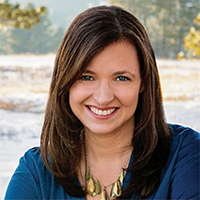
After years spent working with street dogs in Latin America and collecting data on wildlife in Honduras with the Peace Corps, Jessica Higgins of Invera Wealth Advisors of Raymond James never imagined herself working as a financial advisor.
"Not in a million years did I think I would be in financials services," she shares. "The second most surprised person was my mom, who's now my partner."
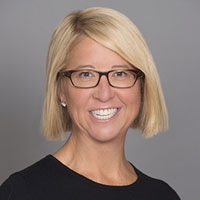
Inside a rug store in South Carolina – or had she crossed into North Carolina? – Vicki Gray was looking to warm up her retirement home when her cellphone rang. She graciously insisted on taking the call.
“I’ll just have a seat over here in the corner,” she said as she began reflecting on her life’s work and those she’d mentored along the way, one of whom being Senior Vice President of Investments Shannon Bennett, CFP®.
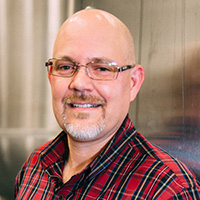
TELL US ABOUT BREWPRINT AND THE AUDIENCE YOU SERVE. HOW DID YOU IDENTIFY YOUR NICHE?
MICHAEL: Our team came over from Merrill Lynch/Bank of America in June 2017. About five years ago, I went through some extra coaching and realized there were a couple of niches I wanted to get into. I love craft beer and make beer myself. If I could find an excuse to go hang out at craft breweries and call it work, it seemed like it would be a happy place to be in life, so I decided I’d like to do something in that space. After spending time with the people in the industry, a couple of things really came out. First, I loved the culture of this industry as much as I loved the product, but I also learned that about 98% of the breweries in California, despite the fact that they had this great love for employees, didn’t have any retirement options. So I thought, “Ah, this is something I can do!”
WHAT MADE RAYMOND JAMES THE RIGHT FIRM FOR YOUR KIND OF BUSINESS?
MICHAEL: Marketing was definitely part of the deal with me moving to Raymond James – being able to work with marketing and building a plan around my presence in the California beer industry and how I could grow that in other states. The marketing team was responsive and offered a very collaborative process, so everything fit with what I was looking for. When I was looking at other firms, no other firm was like Raymond James from a culture standpoint or a willingness to work with you.
WHAT WAS THE PROCESS OF WORKING WITH THE MARKETING TEAM? WHAT DID YOU PUT INTO IT AND WHAT DID YOU GET OUT OF IT?
MICHAEL: My conversation was focused on the Brewprint Advisors website. My account manager did a great job of letting me know where I was in the process and what the next step was. It was a good process that gave me the opportunity to help them understand the culture of the craft brew industry and how that needed to come out in the marketing.
HOW DID YOU COME UP WITH THE NAME “BREWPRINT” AND THE LOGO?
MICHAEL: I struggled with a name for a while. I didn’t want to be pigeonholed in 401(k). I thought about it from an architectural perspective – like building a brewery from a blueprint, which my audience does. Then a friend came up with Brewprint – a financial blueprint for breweries. From a logo standpoint, I wanted something minimalistic, and what the marketing team came up with hit the mark exactly. The logo was important for me to be able to use consistently – that I can easily embroider it on a shirt, create a banner or use in sponsorship materials. It’s a look that’s easily associated with the beer industry.
WHAT WOULD YOU TELL OTHER ADVISORS THEY CAN EXPECT FROM RAYMOND JAMES?
MICHAEL: You’ll definitely get out of the marketing team what you put in. Once you have an idea of what your niche is, and you can communicate effectively with the team, you’ll get exactly what you want. Don’t be afraid of the process or be afraid to share all your information. If you do that, you’re going to be really pleased with the result.
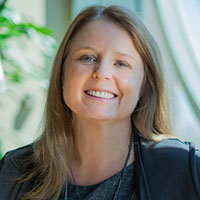
You’ve been a great advocate for using technology to connect with clients.
I feel it’s not good enough to do well for a client, as an advisor I have the responsibility to communicate well and leveraging technology is a very effective tool for communication. For example, during meetings we look over each client’s performance reports and these reviews always generate conversations that extend well beyond the numbers and into other life events and future plans.
I also use our financial planning tool, Goal Planning and Monitoring (GPM), for existing as well as prospective clients. I think GPM is a great way to test drive how a potential client and I will work together, and again, with new and old clients, this use of technology drives conversations far beyond the financial markets.
Having confidence in the quality of the information being generated and the ease with which I can create reports allows me to focus on listening.
Is this a departure from prior experience?
Honestly, I was concerned about technology when I joined Raymond James but soon realized that I had no reason to be. I immediately noticed that the reporting was more flexible and customizable, when I left there, my prior firm approached reports as “one size fits all”.
The way Raymond James approached technology parallels the way the firm allows me to run my practice – fully customizable.
Customizable?
My business has grown, I believe, because I’ve been allowed to let it reflect my personality. My website (www.LynnOpp.com) was created through collaboration with our marketing department. My input drove the process so that the finished product represents exactly who I am.
Additionally, I am free to offer my clients the solutions that fit their needs without fear that I’ll be penalized. Ultimately, I didn’t become a Financial Advisor to be a mortgage broker or a banker. Sure, if there is an opportunity for the client I offer solutions and assist them, but banking is not the driver of my business and I never feel pressured to push products or services to clients.
My whole approach to the client relationship is that “it’s about you, not me.” Credentials are important, but more than anything clients want to know you’re listening to them and putting their needs first. I am totally supported to run my business the way I see fit.
In addition to this support, what is the most compelling thing about Raymond James for you?
Well, I can’t name just one thing but the things that come to mind are freedom, keeping promises, consistency, and great local management.
I didn’t have an appreciation before joining Raymond James for the importance of culture. I’d always prided myself in being focused on my clients, coming into the office, shutting my door and working hard. What I’ve since realized is that culture does slip under the door. I’ve found a home here that is collaborative, not competitive. We have a positive environment to work in every day, which comes from management down. That pleasant and happy environment seeps through the phone to clients, too and I’ve never felt more supported by my manager than I am here.
This is also an office with a lot of other female advisors. While I’m an advisor first and a woman second, I think it’s wonderful to work in an office where there are other people who look like me.
Finally, what has been the biggest surprise since joining Raymond James?
I’ll give you two things: How good the technology is and how much more my clients like Raymond James. I had no idea it mattered to my clients that my prior firm was bank owned, but as soon as I arrived here and having conversations with clients it came up again and again how happy they were I’d made the move.
Thank you.
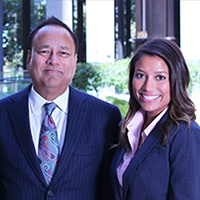
Abu, when you joined our firm a few years ago, you were already a team with Misty. That wasn’t always the case, was it?
I had been a sole practitioner for 25 years when I teamed up with a young advisor. That worked fairly well, but a couple of years into the partnership, an illness brought that to an end. Fortunately for me, around that time Misty became interested in the industry and worked in my office as an intern.
So Misty, you thought this business might be of interest. What was the turning point when you said, “this profession is for me”?
When I started as an intern, I was attracted to the trust and confidence my dad’s clients placed in him and how he made a difference in their lives. This truly is an honorable career. I was somewhat afraid, however, because the industry seemed to be dominated by males. Fortunately, I attended a conference with my dad and heard keynote speaker Sallie Krawcheck speak about encouraging women to join the industry and the rewards of this career. I knew then that the industry was evolving and I could be a part of that change. I have never looked back.
What have you found to be your biggest challenges as a team? Abu, let’s start with you.
My biggest challenge was having my daughter join me in the roughest year I’ve seen in my career, 2008. The other challenge was having her evaluate the way I was running things. After 25 years of doing it my way, her suggestions were not always well received. I am coming around. Recently, for example, I upgraded my flip-phone! Seriously, with her involvement, we became a multigenerational family practice. That’s a net positive for us and for our clients.
Misty?
I think being family allows us to communicate more freely, more directly. We get past the inevitable challenges that present themselves very quickly because we don’t have to worry about how what we say will be received. There’s a sense of trust that I think only comes when it’s family.
You are obviously doing something right. You are enjoying significant growth. Abu?
This team combines the wisdom and confidence that comes with experience with the energy and the ability to directly connect with multiple generations. We’ve been able to reach a younger demographic in a way I was previously unable to attract. This growth is not just coming through new relationships. Misty’s presence is strengthening relationships with our current clients’ children and grandchildren.
So, Misty, you are to blame for this success.
I am certainly making a contribution. I agree that the combination of our individual strengths has contributed to our success. There are lots of young professionals in the San Francisco Bay Area who are accumulating significant assets. Many recognize they need advice. These millennials live on social media and we, our team, depend on social media to help us remain relevant in their world. We could never do this without the expertise and support of our Marketing department. Their capabilities and proactive engagement have really made a difference. In addition to our website, goldengatewealthmanagement.com, Marketing helps us engage social media like Facebook, LinkedIn and Twitter. These tools allow us to scale our activities and make a personal connection to a wider network. We are involved in the social conversation and use these tools in an orchestrated way to create meaningful connections. Our extremely capable registered service associate, Jackie Morales, helps us stay ahead of the process while also attending to the needs of our clients and prospects.
Abu, last thoughts?
It was a wonderful day when Misty told me she wanted to work alongside me. Interestingly, the clients seemed excited as well. They understood that Misty would be my succession plan. She is indeed my succession plan and, while I have no plans on leaving anytime soon, when I do, our clients will be in good hands. I am very proud of Misty.
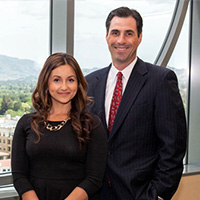
A lot of professionals in this community were surprised to learn that you moved your practice.
They knew I was a dyed-in-the-wool Smith Barney advisor. That firm shared my vision of serving the individual investor and I had zero interest in leaving. Things changed in 2008 when, during the financial crisis, Smith Barney was acquired. At the time I had some preliminary discussions with other firms, but aspects of the acquisition sounded promising so I decided to wait and see what happened. As the years passed, the firm’s philosophy and my own started to separate at an accelerating pace. Once I realized this, I knew I needed to make a change.
So why Raymond James?
When I explored my options, I grew a little jaded with the industry. Most firms started the conversation with how much money they would pay me. Sure, that’s a consideration, but not one firm gave me a convincing reason why my clients should transfer their accounts to their firm. That changed when I visited the Raymond James home office in St. Petersburg. There, no matter who I met or which department they were in, the message was the same – the primary responsibility of the firm is to help advisors serve their clients. This was really driven home when I met with President Tash Elwyn and CEO Paul Reilly. Both reminded me that it’s easy to stay focused on the client when 64% of your revenue comes directly from service to the individual investor. I kept thinking, “Unless this is the biggest snow job in the world, these people truly get it!”
Obviously your transition is still fresh on your mind. Let’s talk about that.
It was not without aggravation, but the firm has a well-defined process and it went better than I anticipated. My assistant, Vanessa Jimenez, joined as well and having her here was a huge help. But it was the support that I received that just blew me away. My wife came to visit me in the office the first night and was shocked to see the receptionist answering the phone and my manager, operations manager, and three other assistants sitting alongside Vanessa making sure the clients were taken care of. It was phenomenal and, honestly, this was one of the first tangible indications that I had indeed made the right decision.
It’s been almost eight months now. How does your reality compare to the perceptions you had prior to joining us?
Frankly, I’ve rediscovered the fun in serving my clients. I spend my days addressing their concerns, not operational issues. Vanessa is happier and more productive. Our back office is responsive and her calls are answered by people who start the conversation with, “How can I help?” Perception versus reality? Late one night, I emailed Tash asking, “Couldn’t you have found at least one jaded, unmotivated and disgruntled employee to work in the back office?” He responded immediately with an “LOL” LOL from the president – that’s cool.
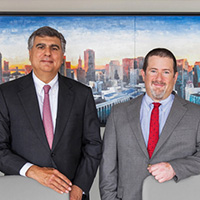
Phil, you have been a member of the San Francisco brokerage community for over three decades. That must be an interesting story.
Actually, I started my career in the Oakland branch of Dean Witter in 1979. Then in 1982, after a brief time with another small investment banking firm, I became one of the founders of Hoefer & Arnett, a boutique firm that specialized in research, trading and investment banking for small- to medium-sized growth companies. Later, one of our specialties became community banks.
San Francisco was an exciting place in the 80s and 90s.
There were some great firms here. Hambrecht & Quist and Montgomery Securities come immediately to mind. Hoefer & Arnett’s focus was not nearly as glamorous. However, no matter where you worked, the city was alive. Everyone was making money. Of course, many were spending it as if the party would never end.
I know you had several responsibilities at Hoefer & Arnett.
As a founder, I took my turn as board member and president. My heart, however, always remained in the work of managing money. I figured out that I was pretty good at discovering undervalued companies. I threw myself into the work and developed a meaningful expertise which, over the years, I have morphed into a successful multi-cap discipline.
Is this when you opened an account with Peter Lynch?
Yes. When you really believe in what you do, it is extremely empowering. I thought for sure that Peter would want to hear one of my ideas. Turns out I was right and we did some business.
Along the way you found time to build a meaningful retail client base.
That was really a conscious decision. I was an early adopter to the concept of fee-based asset management. I also stuck to my knitting while the world around me drove headlong into more of a packaged product focus. This actually accelerated my growth. I have never had to justify my fee because my value-add is in full view monthly on the clients’ brokerage statements.
In 2006, Hoefer & Arnett merged with Howe Barnes.
Yes, they were headquartered in Chicago and basically did in the Midwest exactly what we were doing on the West Coast. It was a convenient way to expand our geographic footprint. I served on their board until we were acquired by Raymond James in 2011.
That had to have been somewhat of a culture shock.
Going in, I had three concerns. Would the firm allow me to continue to operate and grow my practice the way I see fit, would my voice still be heard by senior management, and could I adapt to the culture of a larger organization?
I don’t think I would have gotten through this without my great associate Ben Rose, a Certified Financial Planner, and long-time assistant Ana Pequeneza. It also didn’t hurt that as we got into the process, we started getting positive feedback from clients concerning the RJ statements and online account access.
As for the concerns I mentioned, I continue to operate my practice exactly as I see fit. We have an extremely flat organizational structure so I feel connected with both local and senior management. From day one, I felt completely comfortable here. I cherish our lack of pretentiousness and our firm’s single-minded focus on serving the client – not bad for a company that took no TARP money and has been profitable every quarter since the market crash of 1987!
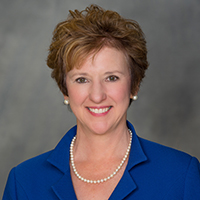
What first attracted you to Raymond James?
Like many advisors who worked at the original Smith Barney, I thought I would never leave. I loved the firm, the technology and its people. But with the news of the merger with Morgan Stanley, it became readily apparent that I needed to make a change. Frankly, when you invited me to visit the home office, I was overwhelmed. There, in the depths of the financial crisis, I found a corporate campus with over 3,000 people genuinely interested in how they could help me serve my clients. I can’t recall exactly when, but at some point during my visit, I felt as if a heavy weight had been lifted from my shoulders. I knew I had found a viable alternative.
So you moved. How was your transition?
I think the anticipation was a lot harder than the transition itself. Raymond James has this down to an art. I was introduced to a transition consultant who stayed with me all the way through my first six months with the firm. I wouldn’t describe the process as painless, but everyone did a great job of making sure I anticipated virtually every potential surprise. Before I transitioned, I had the same fears I’m sure every advisor goes through. Within a few hours of making the announcement, however, I was on the phone talking to clients I’ve served for years. All that fear changed to energy. For me, the whole process was one of the most empowering things I have experienced in my career.
Your practice has experienced dramatic growth since you joined us. Why?
At first, I think the clients sensed a positive change in me. I can’t tell you how many times I heard, “You sound happier.” I really thought I had done a good job of hiding things, but I now realize I couldn’t keep my concerns and apprehensions from clients. I attribute my longer-term growth to my investment in coaching and the team I’ve built with local branch management support. The custom website built by our marketing department is fabulous as well. Being able to effectively brand yourself is more powerful than I had envisioned. Virtually all new relationships tell me they reviewed my website before talking to me – integrewm.com.
You achieved Chairman’s Council this year. What’s next?
I have been in this industry for three decades and feel more confident than ever. I’m wiser now than I have ever been, and I have the pieces in place to really leverage my team. I love what I do. I’m setting goals, learning new things and excited to be building a practice. That said, I have more working days behind me than ahead of me, and at some point I am going to want to step aside. Every step I take is taken with the understanding that I am building a practice that will survive me – one that I will someday sell on my terms.
Given your experience, what advice would you share with advisors?
First and foremost, I would encourage advisors not to underestimate the impact of a negative environment. It always troubles me when I hear advisors say that they just close their door and aren’t affected by the company. Don’t kid yourself! Life and careers are too short to accept a negative, unsupportive environment. View your practice as a business and make sure you choose the right partner for long-term success. I am excited that Integre Wealth Management will be my legacy in this industry. Everything I have built for 30 years can be sustained and nurtured by the principles important to me and my clients. I work with confidence because I know I have a rock-solid partner in Raymond James.

Technology built for advisors and responsive support to help you use it your way.

We offer ownership of your business. In fact, we’ll put that in writing.

Create and promote your brand with a team of more than 100 in-house marketing experts supporting you.